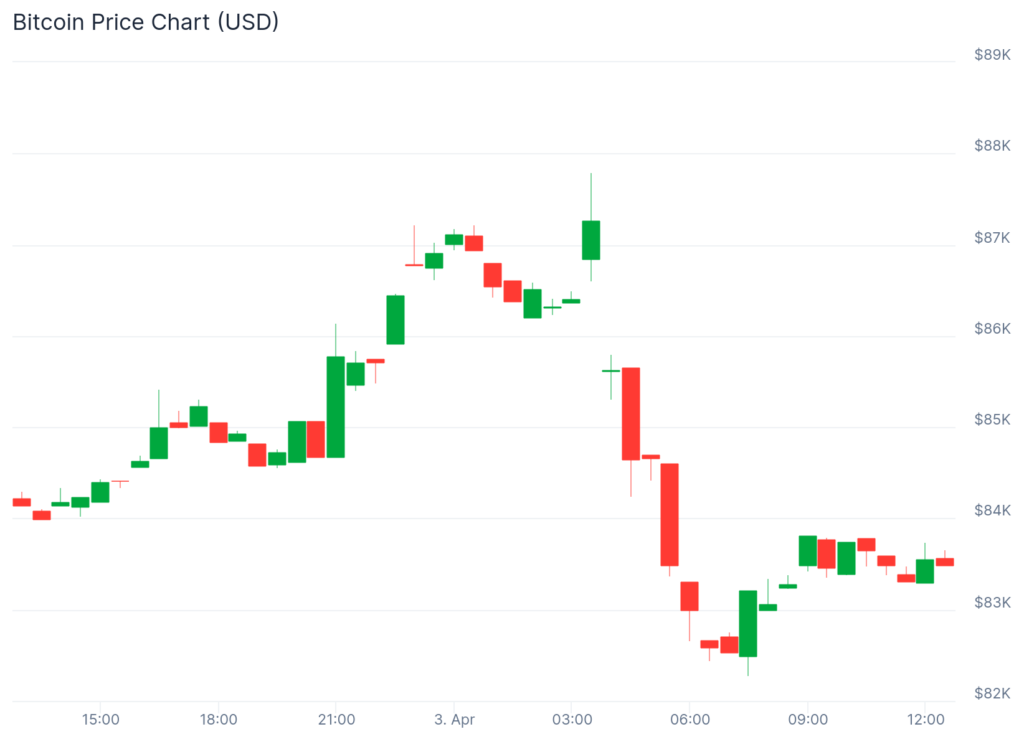In the early hours of April 2 (U.S. time), the crypto market was shaken as U.S. President Donald Trump announced comprehensive tariffs on all countries, marking a new escalation in the trade war.
Trump Announced A Sky-high Retaliatory Tariff in Multiple Countries
During a press conference on April 2, Trump signed an executive order imposing reciprocal tariffs on numerous countries worldwide, aiming to restore what he described as a “fair trade balance” for the United States.
The tariffs target a wide range of goods, with rates varying by country and product. The U.S. will impose a standard 10% import tariff on all goods entering the country, with additional retaliatory tariffs applied to certain specific cases. The standard tariff will take effect on April 5.
More concerning are the new retaliatory rates, described as “unprecedented” and extraordinarily high. For instance, tariffs will be 34% for China, 49% for Cambodia, 46% for Vietnam, 20% for the European Union, 24% for Japan, and 26% for India. These retaliatory tariffs will take effect starting April 9.


Source: White House
Trump described these rates as a “basic and humane” starting point, emphasizing that he can make adjustments in the future depending on the state of U.S. trade relations.
The economic impact of these tariffs is expected to be significant. In the U.S., higher import costs could fuel inflation and slow growth, potentially leading to stagflation. Globally, supply chains may be disrupted, trade volumes reduced, and economic tensions heightened. The Tax Foundation estimates Trump’s tariffs could cut U.S. GDP by 0.4% and cost 358,000 jobs, even before foreign retaliation. The WTO warns such protectionism could further shrink global GDP and deepen uncertainty.
Critics argue the U.S. approach is flawed—basing tariffs on trade deficits rather than actual trade barriers—misrepresents global trade dynamics and could harm international competitiveness.
Harsh Reactions From Countries, Global Trade War Escalates
Analysts are deeply concerned that Trump’s actions will ignite a new global trade war, like China or the European Union (EU). They likely retaliate with their tariffs to protect their domestic economies.
The international response to Trump’s tariff announcement has been swift and critical:
- China’s Ministry of Commerce announced that it would take “resolute countermeasures” against the large-scale tariffs announced by President Trump if the U.S. does not revoke these measures.
- European Commission President Ursula von der Leyen stated, “If negotiations fail, we are prepared to take further countermeasures in response to the U.S. tariffs.”
- Ireland: The Irish foreign minister expressed deep regret over Trump’s tariff decision.
- Brazil: President Lula da Silva’s government announced plans to retaliate against the U.S. tariffs but fears further escalation, as the U.S. could raise its tariffs from 10% to 28% in response.
Despite the backlash, U.S. Treasury Secretary Scott Bessent urged countries not to retaliate, arguing that the tariffs represent a ceiling designed to stabilize markets and reduce the risk of escalating trade tensions. However, this plea is unlikely to deter major economies from taking defensive measures.
A Heavy Blow to Traditional Financial and Crypto Markets
After the news, gold prices surged, surpassing $3,150/oz, as investors flocked to the safe-haven asset to protect their wealth amid rising uncertainty.
However, traditional financial markets and the cryptocurrency sector have not fared as well. The Kobeissi Letter reported that the S&P 500 lost over $2 trillion in market capitalization, with shares of major tech giants like Apple, Microsoft, NVIDIA, Amazon, Alphabet, Meta, and Tesla dropping between 3% and 7% in after-hours trading.
Apr 2, 2025
• President Trump announced a sweeping new tariff plan.
• The U.S. will impose a 10% tariff on all imports and higher rates for some nations.
• U.S. stock futures are tumbling. https://t.co/aISjr4ZHyz pic.twitter.com/sfIacrNN3E
— Brew Markets (@brewmarkets) April 2, 2025
The crypto market has also been hit hard. Initially, news of the 10% tariff caused Bitcoin (BTC) to rise slightly. However, the price plunged sharply from $88,500 to below $83,000 right after the full news. Meanwhile, Ethereum (ETH) dropped over 6%, falling from $1,934 to $1,797, according to CoinGecko. The total crypto market capitalization declined by 5.3% to $2.7 trillion. The Fear & Greed Index hit 25, indicating “extreme fear.”


Source: Coingecko
Learn more: BTC, ETH and XRP Dumped After Trump’s Speech
Optimistic Long-term View
However, Bitcoin’s price had partially recovered then. David Hernandez (21Shares) noted that such sharp volatility is understandable, but clarity can offer long-term benefits. Although the tariffs are higher than expected, the market remains stable and tends to favor certainty.
While Bitcoin (BTC) saw a slight uptick as investors sought refuge in the leading cryptocurrency, most altcoins either stagnated or declined. The Bitcoin dominance index (BTC.D) remains high, indicating that capital heavily concentrates on BTC, leaving altcoins in a state of sideways movement or decline.


Source: TradingView
According to CoinGlass, Bitcoin ETF inflows have increased, signaling confidence in BTC as a hedge against economic uncertainty. However, other crypto ETFs, such as ETH ETF, show no significant signs of optimism. ETH ETF inflows remain flat, and many altcoin-focused funds are experiencing outflows, reflecting a lack of investor confidence in the broader crypto market. This divergence underscores the market’s current risk-averse sentiment, as investors prioritize Bitcoin over smaller, more volatile assets.


Source: Coinglass
The broader crypto market’s stagnation reflects growing fears that Trump’s tariffs could fuel inflation, potentially prompting the Federal Reserve to halt interest rate cuts—a move that would hurt riskier assets like cryptocurrencies. As global trade tensions escalate, both traditional and crypto markets brace for further volatility in the weeks ahead.
 Bitcoin
Bitcoin  Ethereum
Ethereum  Tether
Tether  XRP
XRP  USDC
USDC  Solana
Solana  TRON
TRON  Lido Staked Ether
Lido Staked Ether  Dogecoin
Dogecoin  Figure Heloc
Figure Heloc  Cardano
Cardano  WhiteBIT Coin
WhiteBIT Coin  Bitcoin Cash
Bitcoin Cash  Wrapped stETH
Wrapped stETH  Wrapped Bitcoin
Wrapped Bitcoin  USDS
USDS  Wrapped eETH
Wrapped eETH  Binance Bridged USDT (BNB Smart Chain)
Binance Bridged USDT (BNB Smart Chain)  Chainlink
Chainlink  Monero
Monero  LEO Token
LEO Token  WETH
WETH  Zcash
Zcash  Stellar
Stellar  Hyperliquid
Hyperliquid  Coinbase Wrapped BTC
Coinbase Wrapped BTC  Ethena USDe
Ethena USDe  Litecoin
Litecoin  Sui
Sui  Avalanche
Avalanche  Hedera
Hedera  sUSDS
sUSDS  Shiba Inu
Shiba Inu  USDT0
USDT0  Dai
Dai  Uniswap
Uniswap  PayPal USD
PayPal USD  Mantle
Mantle  Canton
Canton  Cronos
Cronos  World Liberty Financial
World Liberty Financial  Toncoin
Toncoin  Ethena Staked USDe
Ethena Staked USDe  Polkadot
Polkadot  USD1
USD1  Aave
Aave  Rain
Rain  Bitget Token
Bitget Token 


